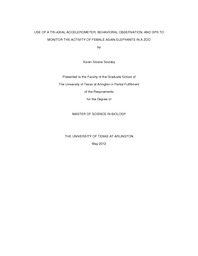| dc.contributor.author | Soulsby, Karen Sloane | en_US |
| dc.date.accessioned | 2013-07-22T20:14:06Z | |
| dc.date.available | 2013-07-22T20:14:06Z | |
| dc.date.issued | 2013-07-22 | |
| dc.date.submitted | January 2013 | en_US |
| dc.identifier.other | DISS-12242 | en_US |
| dc.identifier.uri | http://hdl.handle.net/10106/11837 | |
| dc.description.abstract | Wild elephants spend approximately 90% of their day actively foraging. Reduced activity in captive elephants may increase the risk of obesity and the formation of stereotypical behaviors. In order to evaluate and enhance strategies for managing elephants in captivity, new methods to quantify elephant activity are needed. GPS has been used to measure distances walked during the day in captive elephants. An accelerometer may also be a useful tool for quantifying elephant activity including recording specific behavior patterns without the need for constant observation. In this study, tri-axial accelerometers were tested for measurements of total activity, distances traveled, and activity budget in four female Asian elephants at the Fort Worth Zoo in Fort Worth, Texas. Elephants wore accelerometers and GPS units during their normal husbandry routine over a period of 26 days. The accuracy of the developed definitions for select behaviors and the distances traveled by the elephants were evaluated from accelerometer and GPS data. Bamboo was provided as enrichment for 8 of the study days and accelerometers were used to measure the effects of the environmental enrichment on the behavior of the elephants. Accelerometers had a ±7 meter error when estimating distances traveled and > 90% accuracy when defining specific behaviors. GPS units had a ± 3.7 meter error when elephants were constantly moving however, when measuring distances traveled by the elephants over the course of the day GPS greatly overestimated the distance. The accelerometer detected a 30% increase (p< 0.05) in activity on enrichment days versus days without enrichment in one of the four elephants. Overall, elephant spent less time statuary and less time performing stereotypical behaviors when enrichment was provided. Tri-axial accelerometers were found to be a useful tool for quantifying walking, standing, and stereotypical behaviors in elephants over long periods of time but could not differentiate trunk behaviors such as contacting object or eating when located on the top of the neck. These results indicate that it would be worthwhile to further validate accelerometer measurements with measurements of energy expenditure in elephants. This study can be used as a starting point to further our understanding of captive elephant behavior and how tools such as the accelerometer may be used to gather information about activity and aid in the development of management plans for elephants in zoos. | en_US |
| dc.description.sponsorship | Formanowicz, Daniel | en_US |
| dc.language.iso | en | en_US |
| dc.publisher | Biology | en_US |
| dc.title | Use Of A Tri-axial Accelerometer, Behavioral Observation, And GPS To Monitor The Activity Of Female Asian Elephants In A Zoo | en_US |
| dc.type | M.S. | en_US |
| dc.contributor.committeeChair | Formanowicz, Daniel | en_US |
| dc.degree.department | Biology | en_US |
| dc.degree.discipline | Biology | en_US |
| dc.degree.grantor | University of Texas at Arlington | en_US |
| dc.degree.level | masters | en_US |
| dc.degree.name | M.S. | en_US |

